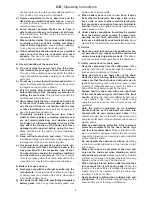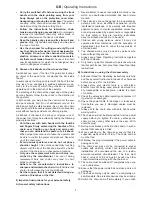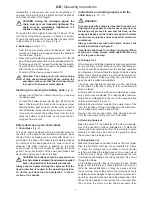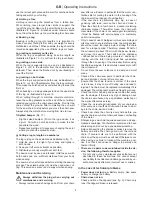
GB
|
Operating Instructions
7
temperature it will expand and must be retightened. A
new saw chain will have to be tightened more frequently
until it has reached its full length.
CAUTION: During the running-in period, the
chain must be more frequently tightened. The
chain must be immediately retightened if it
shakes or leaves the grove!
To tension the chain slightly loosen the T-screw 4. Then
turn the knurling wheel upwards (+ direction of arrow).
Tension the chain such that it can be lifted by about 3mm
in the middle of the bar, as shown in Fig. 5.
4. Switching on
(Fig. 6 + 7)
• Hold the saw securely with both hands so that the
thumbs and fingers are wrapped around the handle of
the chain saw (Fig. 6).
• Press with your thumbs the stopping button 11 on the left
side of the rear handle and then the operating switch 12.
• The stopping button 11 is used for unlocking the switch-
on mechanism and does not need to be pressed again
after the device is switched on.
• To switch off the device, release switch 12.
Attention: The sawing chain will start running
at high speed immediately. When putting the
saw down, make sure that the chain never gets
in touch with stones or metal objects.
Inserting or removing the battery pack
(Fig. 8)
• Always turn off the tool, before removing or inserting
the battery pack.
•
To insert the battery paack into the tool, first bring the
base of the tool with the notch in the housing on a line.
Slide the battery pack firmly into the tool until you hear a
click. Otherwise, it may result in injury to you or others.
• If you want to remove the battery block from the tool,
press the buttons on both sides, and remove the bat-
tery pack from the tool.
Safety devices on your chain brake
1. Chain brake
(Fig. 9)
This chain saw is equipped with a mechanical brake for
the chain. In the case of uncontrolled movements, when
the tip of the sax blade gets in contact with wood or a
solid object, the drive of the chain is immediately stopped
by activation of the hand guard 8, the motor will not be
stopped. This brake function is initiated by the back
of your hand on the front handle 10 pushing the hand
guard. The proper function of the saw chain brake shall
be checked before each use of the saw.
CAUTION: No buttons should be pressed when
the chain brake is released (hand protection pulled
back in the direction of the handle and locked).
Always ensure before starting the chainsaw that the
hand protection is locked in the operating position.
To do this, pull back the hand protection in the di-
rection of the handle.
Instructions on working properly with the
chain saw
(Fig. 10 - 17)
WARNING!
Only saw logs with a diameter less than the saw’s cut-
ting length. Lay people and home users may not use
the plunge cut process to saw and fell trees, as this
causes a kickback on the chain saw and can therefore
result in severe injuries and even death in certain cir-
cumstances
Always hold the saw with both hands; observe the
safety instructions and figure 6.
Important instructions for cutting and lopping: When
sawing on a slope, always stand uphill from the log
as the log can roll away!
a) Felling a Tree
When bucking and felling operations are being performed
by two or more persons, at the same time, the felling op-
eration should be separated from the bucking operation
by a distance of at least twice the height of the tree being
felled. Trees should be felled in a manner that would en-
danger any person, strike any utility line, the utility com-
pany should be notified immediately.
The chain saw operator should keep on the uphill side
of the terrain as the tree is likely to roll or slide downhill
after it is felled.
A retreat path should be planned and cleared as neces-
sary before cuts are started. The retreat path should ex-
tend back and diagonally to the rear of the expected line
of fall as illustrated in Figure 11.
Before felling is started, consider the natural lean of the
tree, the location of larger branches and the wind direc-
tion to judge which way the tree will fall.
Remove dirt, stones, loose bark, nails, staples, and wire
from the tree where felling cuts are to be made.
b) Notching Undercut
Make the notch 1/3 the diameter of the tree, perpendic-
ular to the direction of fall as illustrated in 10. Make the
lower horiziontal notching cut first. This will help to avoid
pinching of either the saw chain or the guide bar when
the second notch is being made.
c) Felling Back Cut
Make the felling back cut at least 2 inches (50 mm) higher
than the horizontal notching cut as illustrated in Figure
11. Keep the felling back cut parallel to the horizontal
notching cut. Make the felling back cut so enough wood
is left to act as a hinge. The hinge wood keeps the tree
from twisting and falling in the wrong direction. Do not cut
through the hinge.
As the felling cut gets close to the hinge the tree should
begin to fall. If there is any chance that the tree may not
fall in the desired direction or it may rock back and bind
the saw chain, stop cutting before the felling back cut is
complete and use wedges of wood, plastic or aluminum to
open the cut and drop the tree along the desired line of fall.
When the tree begins to fall remove the chain saw from
the cut, stop the motor, put the chain saw down, then
Summary of Contents for AKS 4030
Page 2: ......
Page 4: ...3 mm 5 1 14 2 4 6 3 3 4 5 A 3 B...
Page 6: ...13 14 2 1 15 16 2 1 9 17 12...
Page 47: ......
Page 48: ......
















































